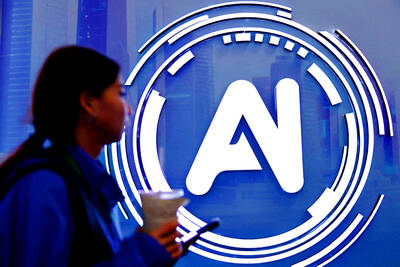Samsung Electronics Co unveiled a number of forthcoming advancements to its technology aimed at attracting makers of artificial intelligence (AI) chips.
Although, Samsung is the world’s No. 1 memorychip maker, it has been trying to catch up with rival Taiwan Semiconductor Manufacturing Co (TSMC, 台積電) in the foundry market, where companies manufacture customer-designed chips.
Samsung’s share in the foundry market slid to 11 percent in the first quarter of this year from 11.3 percent in the previous quarter, while TSMC’s share climbed to 61.7 percent from 61.2 percent during the same period, according to Taipei-based research house TrendForce Corp (集邦科技).

Photo: AFP
Samsung on Wednesday announced several new types of production technology and laid out its chipmaking road map and outlined its vision for the AI era at its annual foundry forum in San Jose, California.
The advanced process introduced by Samsung uses so-called backside power delivery network technology, which places power rails on the backside of a silicon wafer. Such technology enhances power, performance and area, while significantly reducing the drop in voltage, compared with its first-generation 2-nanometer process, the company said.
The South Korean chipmaker also said that its ability to offer logic, memory and advanced packaging would help it make rapid progress in winning outsourced semiconductor manufacturing orders for AI-related chips.
The company predicted that its AI-related customer list would expand five-fold and revenue would increase by nine times over current levels by 2028.
Samsung executives declined to comment on the status of the company’s attempts to supply the latest advanced memory chips to Nvidia Corp, which produces AI accelerators that are a must-have for all large technology companies.
They also did not respond to reports that it has not yet been able to achieve qualification of such chips at the US company.
The company touted its gate-all-around (GAA) technology, which is key for AI products.
Samsung said it plans to mass produce its second-generation 3-nanometer process in the second half of this year and deliver GAA on its upcoming 2-nanometer process.
In 2022, the company became the first in the industry to begin GAA-based 3-nanometer mass production.
The chipmaker affirmed that its preparations for 1.4-nanometer are progressing smoothly, with performance and yield targets on track for mass production in 2027.

CHIP RACE: Three years of overbroad export controls drove foreign competitors to pursue their own AI chips, and ‘cost US taxpayers billions of dollars,’ Nvidia said China has figured out the US strategy for allowing it to buy Nvidia Corp’s H200s and is rejecting the artificial intelligence (AI) chip in favor of domestically developed semiconductors, White House AI adviser David Sacks said, citing news reports. US President Donald Trump on Monday said that he would allow shipments of Nvidia’s H200 chips to China, part of an administration effort backed by Sacks to challenge Chinese tech champions such as Huawei Technologies Co (華為) by bringing US competition to their home market. On Friday, Sacks signaled that he was uncertain about whether that approach would work. “They’re rejecting our chips,” Sacks

It is challenging to build infrastructure in much of Europe. Constrained budgets and polarized politics tend to undermine long-term projects, forcing officials to react to emergencies rather than plan for the future. Not in Austria. Today, the country is to officially open its Koralmbahn tunnel, the 5.9 billion euro (US$6.9 billion) centerpiece of a groundbreaking new railway that will eventually run from Poland’s Baltic coast to the Adriatic Sea, transforming travel within Austria and positioning the Alpine nation at the forefront of logistics in Europe. “It is Austria’s biggest socio-economic experiment in over a century,” said Eric Kirschner, an economist at Graz-based Joanneum

BUBBLE? Only a handful of companies are seeing rapid revenue growth and higher valuations, and it is not enough to call the AI trend a transformation, an analyst said Artificial intelligence (AI) is entering a more challenging phase next year as companies move beyond experimentation and begin demanding clear financial returns from a technology that has delivered big gains to only a small group of early adopters, PricewaterhouseCoopers (PwC) Taiwan said yesterday. Most organizations have been able to justify AI investments through cost recovery or modest efficiency gains, but few have achieved meaningful revenue growth or long-term competitive advantage, the consultancy said in its 2026 AI Business Predictions report. This growing performance gap is forcing executives to reconsider how AI is deployed across their organizations, it said. “Many companies

France is developing domestic production of electric vehicle (EV) batteries with an eye on industrial independence, but Asian experts are proving key in launching operations. In the Verkor factory outside the northern city of Dunkirk, which was inaugurated on Thursday, foreign specialists, notably from South Korea and Malaysia, are training the local staff. Verkor is the third battery gigafactory to open in northern France in a region that has become known as “Battery Valley.” At the Automotive Energy Supply Corp (AESC) factory near the city of Douai, where production has been under way for several months, Chinese engineers and technicians supervise French recruits. “They